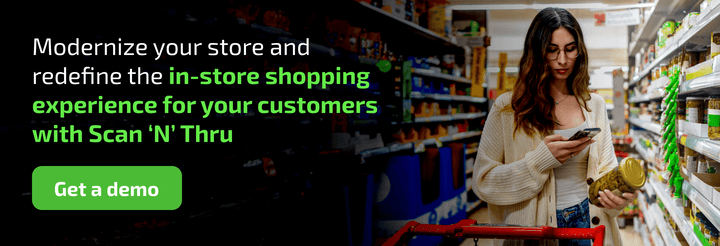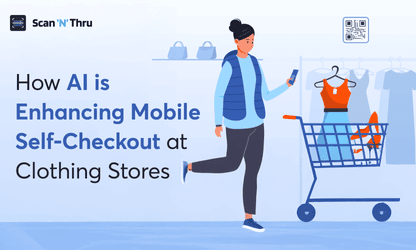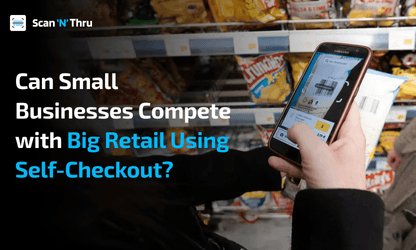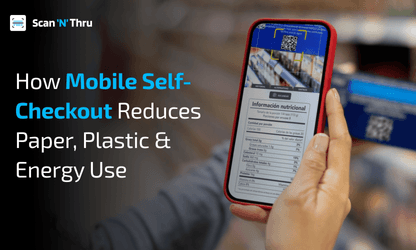Most retailers don’t question the way things have always been done. That’s only until the numbers start slipping.
Aisles, checkouts, and staffing models still follow decades-old routines, despite how drastically shopper expectations have evolved.
That disconnect is starting to show. Frustrated customers. Bottlenecked checkouts. Slimmer margins. These are no longer isolated issues. They reflect broader retail industry challenges. New technologies always force a rethink. Scan and go technology is doing that in retail. It is forcing retailers to question long-standing practices—and that’s exactly what the industry needs.
In this blog, you will learn about the norms scan and go disrupts, why they were never built for modern retail, and how this shift leads to stronger operations and better customer experiences.
Let’s get started.
What are some of the most common traditional retail norms?
Many retailers haven’t kept up with how people shop today. They rely on old models just because they are still operational.
No doubt, these norms are still familiar and work just fine. But they often create barriers to efficiency, flexibility, and customer satisfaction.
Let’s take a closer look at the ones still shaping many in-store experiences.
Fixed checkout counters
Most retail stores are built around a centralized checkout zone. It’s where every shopper has to go for checkout and payment, no matter how small their purchase.
But this setup creates unnecessary congestion, especially in smaller stores. It is a challenge faced by retailers in almost every sector.
Besides, you can’t scale it when traffic spikes in your store, and it limits your ability to rethink store flow.
Hence, your checkout area often becomes a source of frustration rather than convenience.
Staff-managed transactions and checkouts
Traditional retail stores depend heavily on store staff to process every sale. That means when it’s busy, more staff members are pulled to the register, which leaves fewer people available to help your customers on the floor.
It’s a rigid system that doesn’t adapt well to fluctuating foot traffic. Plus, it puts pressure on labor resources that are already stretched thin.
Queue-based customer flow
Long lines in stores aren’t just frustrating; they’re ingrained into how stores are designed. This is because shoppers are expected to finish browsing, get in line, and wait for their turn.
This is among the most common challenges faced by retailers. And it affects everything from store layout to how your customers move through the space. Instead of a fluid and intuitive shopping journey, they’re often funneled into fixed paths and forced to pause their momentum at the end.
Linear in-store journeys
Retail floor plans often guide customers from the entrance to the checkout in a straight line, with little room for deviation. Promotions and displays are also structured around this fixed path.
But that kind of rigid flow doesn’t work for all shoppers, or all store types.
It limits freedom and makes it harder to test new merchandising strategies or spontaneous discovery moments.
Fragmented digital integration
Even retailers who use loyalty apps or gift cards, digital tools often work in isolation. That means a customer might scan their loyalty card at the register, use a separate app to pay, and receive a paper receipt at the end.
This fragmentation creates unnecessary friction and undermines the opportunity to create a seamless digital-meets-physical experience.
What are some disadvantages associated with traditional retail models?
Many of these norms don’t just feel outdated; they directly impact your business performance in many ways.
Here’s where the cracks start to show:
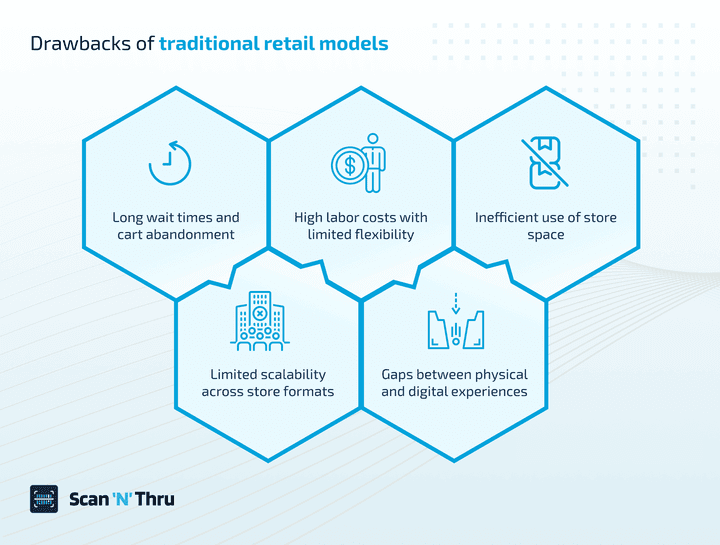
Long wait times and cart abandonment
People come to physical stores because, unlike online shopping, they can get the products immediately after paying. That’s why no one likes waiting in lines.
And when queues get too long, customers walk away—sometimes leaving full carts behind. That’s a double whammy. Because you lose revenue, and they leave with a negative impression.
Retail businesses like yours often underestimate how much sales they lose this way. But small moments of friction, especially at checkout, can have a big impact on conversion.
High labor costs with limited flexibility
Relying on human cashiers for every transaction makes it harder to manage labor efficiently. Besides, you can’t easily scale staff up and down by the hour.
That means it’s likely that your store will be short-staffed during peak periods and over-staffed during slow business hours.
And that leaves fewer resources for tasks that drive long-term value, like customer assistance, merchandising, or store maintenance.
Inefficient use of store space
This is a retail business challenge that often gets overlooked. Dedicated checkout areas or cash registers eat up valuable floor space in your store. You’re locked into a fixed layout, even if your customer needs change or you want to experiment with different formats.
Well, the thing is, every square foot matters. And traditional checkouts and cash registers just don’t offer enough return.
Limited scalability across store formats
Whether it’s a big-box, a convenience-sized express location, or a pop-up store, the old checkout model doesn’t adapt easily. Installing fixed registers and counter setups takes time, money, and infrastructure.
All that makes it harder to experiment with new formats or expand quickly when you spot a market opportunity.
Gaps between physical and digital experiences
When your loyalty programs, payments, and promotions don’t connect in one place, you miss opportunities to personalize the customer experience. You even miss out on the chance to track what’s working.
Data is limited or scattered, and customers don’t get the smooth, app-driven experience they’re used to from digital platforms.
It’s a missed opportunity to turn in-store moments into relationship-building touchpoints.
How scan and go redefine in-store shopping
Scan and go systems change the assumptions retailers (and consumers) have lived with for decades.
This technology shifts control to the customer and removes checkout friction to create a more agile and modern store experience.
Here’s how it redefines in-store shopping and solves some of the biggest challenges in the retail industry:
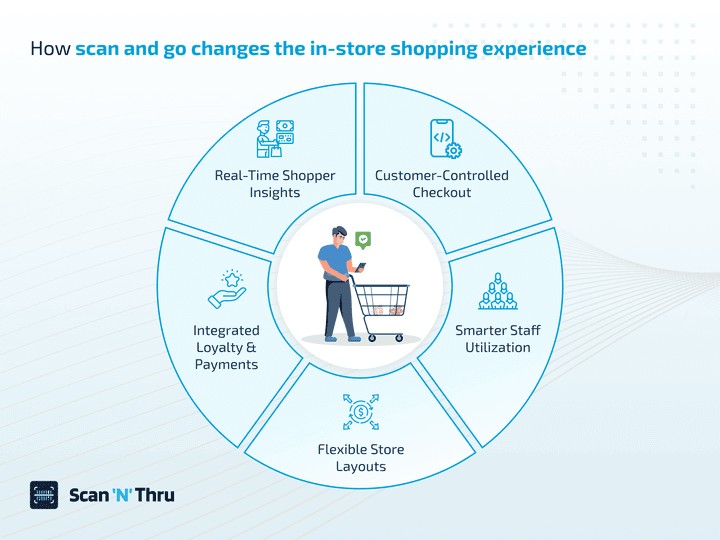
Provides autonomy to customers to shop with their phones
With scan and go apps, shoppers use their smartphones to scan products and add them to their cart as they go around your shop. When they have got everything they need, then they can check out and pay directly in the app. No lines. No terminals. No waiting.
You give your customers full control over how and when they complete their purchase. That sense of autonomy often leads to faster, more satisfying shopping experiences. Plus, it also leads to higher conversions.
Frees up staff to focus on value-added roles
Instead of standing behind a register, your team members can:
- Assist customers on the floor
- Answer questions
- Create memorable interactions
That shift in focus—from transaction processing to customer engagement—can elevate your in-store service without increasing labor costs.
Enables dynamic and flexible store layouts
Scan and go technology removes the need for fixed checkout infrastructure. That means you can rethink your store layout entirely.
You can open up space for curated displays, event zones, or more immersive product experiences that were previously taken up by cash registers or counters.
It’s an approach that’s quite effective in small-format or urban stores, where every square foot matters.
Seamlessly integrates loyalty and digital payments
With the right scan and go solution, loyalty and reward programs, offers, and contactless payments are all built in. Customers can redeem points, apply discounts, and pay—all in one step.
This creates a cohesive and rewarding experience without the need for separate apps, cards, or processes.
Captures real-time data on customer behavior
Scan and go systems give you insights into how your customers shop in your store, not just what they buy.
These systems provide you with insights on things like dwell times, discover where baskets grow, and better understand what drives conversion.
It’s the kind of data online retailers rely on daily, and now, brick-and-mortar stores can get that as well.
3 reasons why this technological shift is good for the future of retail
Scan and go isn’t just a technical upgrade; it’s a strategic shift that opens the door to a better retail future. Here’s why that matters.
It aligns with how customers want to shop
Speed, convenience, control, and personalization are what most customers demand today. They’re among the basic shopping expectations, especially among younger shoppers who are used to managing everything from their phone.
Meeting these expectations is among the most pressing challenges faced by global retailers.
Scan and go directly supports these preferences. It lets them shop on their terms, without unnecessary delays or barriers.
It supports more sustainable and efficient retail operations
Scan and go apps reduce reliance on fixed infrastructure and front-end labor, which remarkably lowers your operational costs.
Besides, this retail technology also makes your store more adaptable and able to handle customer traffic surges or layout changes with ease.
You end up with a leaner, more flexible model that scales more easily across locations.
Read more: How Scan and Go Redefines Retail Shopping Experience
It positions physical retail to compete with online shopping
When in-store shopping feels as seamless and personalized as e-commerce, it becomes a real alternative, not a fallback.
And scan and go does exactly that—it brings digital convenience into the store. It bridges the gap between online expectations and offline experiences.
It makes offline stores more immersive and experiential so that businesses like yours stay relevant, compelling, and competitive.
Final thoughts
So, it’s clear: Holding onto these traditional retail norms can often be a source of your customers’ frustration. And it also limits how agile and efficient your business can be.
Technologies like scan and go, also known as mobile self-checkout solutions for retail, change the dynamics of in-store shopping for both businesses and consumers.
It removes the physical and operational constraints that slow stores down and puts power back into your customers’ hands. When shoppers can scan, pay, and leave with their phone, the entire store experience becomes more fluid—and more aligned with how people actually want to shop.
And that’s where Scan ‘N’ Thru stands out.
It’s more than just self-checkout on a smartphone screen.
Scan ‘N’ Thru gives you a complete mobile-first retail platform—one that handles everything from barcode scanning to digital cart management, loyalty integration, and flexible payment options.
Shoppers get real-time pricing, personalized product recommendations, and instant access to receipts. Plus, you get a system that reduces queue-related churn, lowers labor costs, and gives you rich data on how your customers behave in-store.
And the best part is that you don’t need to add any infrastructure or equipment. Hence, you can roll it out without redesigning your store or overhauling your tech stack. It fits into your existing operations and starts delivering value from day one.
Mobile-based self-checkout is a strategic tool for modern retail success and to overcome various technology challenges in retail.
With tools like Scan ‘N’ Thru, you can move fast, stay flexible, and finally break free from the limitations of traditional checkout.
